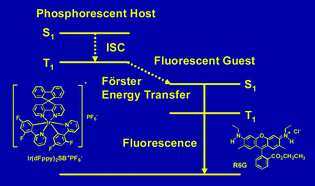Solid-state light-emitting electrochemical cells employing phosphor-sensitized fluorescence
Abstract
We report highly efficient

* Corresponding authors
a
Institute of Lighting and Energy Photonics, National Chiao Tung University, Tainan, Taiwan, Republic of China
E-mail:
haichingsu@mail.nctu.edu.tw
Fax: +886-6-3032535
Tel: +886-6-3032121-57792
b Department of Electrical Engineering, Graduate Institute of Photonics and Optoelectronics, Graduate Institute of Electronics Engineering, National Taiwan University, Taipei, Taiwan, Republic of China
c Department of Chemistry, National Taiwan University, Taipei, Taiwan, Republic of China
We report highly efficient

 Please wait while we load your content...
Something went wrong. Try again?
Please wait while we load your content...
Something went wrong. Try again?
H. Su, Y. Lin, C. Chang, H. Lin, C. Wu, F. Fang, H. Chen and K. Wong, J. Mater. Chem., 2010, 20, 5521 DOI: 10.1039/C0JM00429D
To request permission to reproduce material from this article, please go to the Copyright Clearance Center request page.
If you are an author contributing to an RSC publication, you do not need to request permission provided correct acknowledgement is given.
If you are the author of this article, you do not need to request permission to reproduce figures and diagrams provided correct acknowledgement is given. If you want to reproduce the whole article in a third-party publication (excluding your thesis/dissertation for which permission is not required) please go to the Copyright Clearance Center request page.
Read more about how to correctly acknowledge RSC content.
 Fetching data from CrossRef.
Fetching data from CrossRef.
This may take some time to load.
Loading related content
